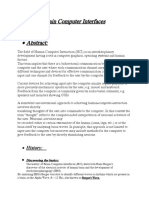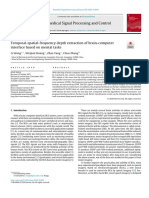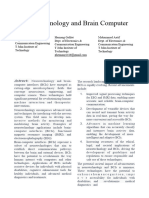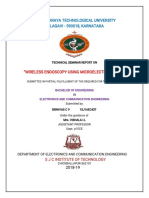Brain-Computer Interface Review: Szilárd BULÁRKA Aurel Gontean
Brain-Computer Interface Review: Szilárd BULÁRKA Aurel Gontean
Uploaded by
Kavya M NayakCopyright:
Available Formats
Brain-Computer Interface Review: Szilárd BULÁRKA Aurel Gontean
Brain-Computer Interface Review: Szilárd BULÁRKA Aurel Gontean
Uploaded by
Kavya M NayakOriginal Title
Copyright
Available Formats
Share this document
Did you find this document useful?
Is this content inappropriate?
Copyright:
Available Formats
Brain-Computer Interface Review: Szilárd BULÁRKA Aurel Gontean
Brain-Computer Interface Review: Szilárd BULÁRKA Aurel Gontean
Uploaded by
Kavya M NayakCopyright:
Available Formats
Brain-Computer Interface Review
Szilárd BULÁRKA Aurel GONTEAN
Applied Electronics Department Applied Electronics Department
University of Politehnica Timisoara University of Politehnica Timisoara
Timisoara, Timis Timisoara, Timis
szilard.bularka@student.upt.ro aurel.goneant@upt.ro
Abstract— Brain-Computer Interface (BCI) is a device that silicon sensor placement for ECoG, fMRI play a key role.
allows direct communication path between central nervous Todays BCI requirements are: good temporal and spatial
system and external devices without peripheral nerves resolution, mobility, user friendliness, ethical, discreteness,
dependency. Brain-Computer Interface and its applications robustness. fMRI and fNIR are used mainly as research tools
reached beyond medical applications, it is used to enhance, because the imaging process of those is time-consuming and
improve, restore or replace functions or it can be used as a the mobility of the user is highly restricted. For modern BCIs
research tool. Stakeholders of the field have developed future EEG and ECoG offers optimal performances and mobility.
plans and the ethical in research. the multidisciplinary nature of ECoG is a highly invasive method and involve higher costs
Brain-Computer Interface is based on neuroscience, signal
but the silicone based sensors offer higher signal to noise ratio,
processing, biomedical sensors, and hardware. This paper aims
to present briefly the current state and the future of Brain-
better spatial resolution, ease of use and most of them offer
Computer Interfaces. The future works of the author are based discreteness. ECoG is mainly used in replace and restore
on hardware approach using System-On-Chip combined with applications. Thanks to its noninvasiveness EEG is preferred
novelty memristor crossbar memory, which can be used to for most of the applications, nowadays dry electrodes offer
emulate axons and neurons directly in the hardware. ease of use and discreteness. Using novelty signal processing
techniques the performance of EEG systems has been
Keywords—Brain-Computer Interface,BCI, state of the art, BCI increased in the last years. The appearance of medical graded
applications, neuroscience, computational neuroscience gadget EEG headsets like EPOC by Emotiv, Muse by
Interaxon, etc. have opened a new application area in the field
I. INTRODUCTION of entertainment and mental state monitoring for BCI. The
reduced cost and the performances offered by most of these
The brain-computer interface is a device that allows direct devices offer the possibility to young scientists to contribute to
communication path between the brain and external devices research. Because the field of BCI research is a young and
without peripheral nerves dependency. .In the early days BCI growing, BNCI Horizon 2020 [1] is a Coordination and
was more a science fiction topic, nowadays thanks to the huge Support Action founded within the European Commission's
advancements in neuroscience, signal processing, Framework Programme 7 to facilitate the communication and
computational neuroscience, sensors etc. BCI is a growing collaboration between stakeholders. BNCI Horizon 2020 have
area of research. Since Hans Berger has recorded the neuron proposed a roadmap which includes the current state and a
firing process in 1924 using electroencephalography, (EEG) guideline for future applications. The BCI Awards [2] donated
unlocked the possibility to investigate schizophrenia and other by g.tec offer a good overview of outstanding and innovative
brain diseases. Nowadays among EEG we can monitor the research projects in the field of BCI research. On the other
brain waves using various novelty noninvasive methods like hand, the BCI Awards offer a good dataset for benchmarking.
Functional Magnetic Resonance Imaging (fMRI), Functional
Near-infrared Spectroscopy Imaging (fNIR) and invasive
methods like Electrocorticography (ECoG). In the early days
of BCI, the main applications were focused on motor
rehabilitation. Nowadays BCI is used beyond medical
applications like entertainment, military, research tool, etc.
The reasoning why most of the BCI applications are motor
related is strongly correlated why animals need brains.
According to Daniel Wolpert, the need for a brain is related to
movement. The studies of squids can argue with D. Wolpert's
Figure. 1. Emotiv EPOC 16 chanel EEG headset (left), 128 chanel 3D neural
hypothesis. Squids use their brain to swim and to find their probe for ECoG by Neuro Nexus (right)
attachment place, after the attachment to the bottom of the
ocean, it digests its own brain. Thanks to neuroscience a lot of
the brain was reverse engineered. The 10/20 electrode II. CURRENT STATE OF BCI
placement for EEG offer satisfactory spatial coverage for most In the early days, BCI was mainly used in medical
of the applications, but for sophisticated applications like applications. Nowadays as the performances, the discreteness
978-1-5090-3748-3/16/$31.00 ©2016 IEEE
and the costs have seen a great improvement, BCI can be used
in almost every domain where human to machine interaction
can be imagined. According to BNCI Horizon 2020, the
author embraces the five application areas for BCIs.
A. BCI used to replace functions
BCI can offer a solution for patients with disabilities
caused by chronic diseases. In case of stroke many people loss
their motor functions or their ability to speak. The first attempt
to create a new communication path using BCI for patients
with severe motor disabilities was based on cursor Figure. 2. Ear-EEG [4]
movements. According to G. E. Fabiani et. al [7] the overall
In BCI four paradigms are used, P300 signals, motor imagery,
system performance depend on the number of features and the
Steady State Visual Evoked Potentials (SSVEP) and Slow
classification method. The use of linear discriminant analysis
Cortical Potentials. A.A Tores-Garcia et. al. have proposed a
(LDA) can offer optimal performances for linear separable
new paradigm for speech classification called imagined
data. Non-linear classifiers (like. statistical classifiers or
speech. [14].
neuronal networks) can offer better performances but the
number of features needs to be carefully chosen thanks to the
exponential relation between the number of weights and the B. BCI used to restore functions
number of features. One of the most popular applications for BCI is a potential method for stroke rehabilitation. Using
BCI is wheelchair control. EEG-based methods suffer from signals from the brain to control assistive devices like assistive
lack of accuracy and low signal to noise ratio. In order to robots or muscle stimulators. Earlier studies have
maximize the overall system performance, various methods demonstrated that ipsilateral areas to the moving limb are
were proposed to ensure low-cost function and safety.Velocity responsible for execution and planning. D.T Bundy et. al.
and direction control proportional with the concentration level demonstrated for the first time that contralesional hemispheric
and time was embraced by many authors. The main EEG signals can be used to control cursor movements in one
disadvantage is caused by the rapid exhaustion of the user. dimension. [3].
According to R. Satti [9] a shared control strategy can offer
better performances, where the computer can assist the user to C. BCI used to improve functions
ensure safety and to minimize the cost function. The cost Thanks to novelty wearable EEG devices which can be
function in terms of wheelchair application is defined as the used long time periods without intervention BCI applications
sum of concentration time ratio and mission time ratio. In gained place also in health improvement. D. Looney et. al.
order to create shared control systems the wheelchair need to proposed an Ear-EEG device for continuous brain monitoring
be equipped with environmental sensors (i.e infrared sensors, applications. The proposed device consisted of an ear plug
vision, etc) and trajectory control to minimize the number of (fig. 2) with embedded electrodes to record brain waves within
commands and collision avoidance. According to L. Merino the ear canal. [4]. A recent application proposed by B.
et. al. [16] BCIs based on Steady State Visual Envoked Mirkovic et. al. is a hearing device control using BCI. [19].
Potentials (SSVEP) does not require training as Motor Using continuous EEG speech envelope tracking can be made
Imagery based BCIs. In the related work six 3x3 cm flickering in order to detect the direction of attention to a natural speech.
stimulus was used with color and frequency changing, each The above study proves that continuous EEG offer lower
flickering square indicating a command. The SSVEP accuracy than scalp EEG due to the lower number of
frequency detection was made using Canonical Correlation electrodes, but both offer sufficient decoding accuracy.
Analysis (CCA). The proposed method offered robustness and Another recent BCI application is related to memory
good accuracy across multiple users. The main benefit of this improvement using wearable EEG headset. According to M.
method is the easiness to add more commands without the Avaneh, et al. parietal and occipital EEG signal amplitude
need for a training session. Using a webcam feedback with the measurements from 1-2s after the onset can be used to identify
proposed method to control a quadcopter is a novelty poorly or well-memorized words. [20]
application of BCI. The second most studied BCI application
after movement is related to speech synthesizing. According to
D. BCI used to enhance functions
J. S. Brumberg, the discrete classification of vowels and
consonants is very difficult. Motor imagery is suitable for One of the main limitation in BCI performance is due to
continuous control like mouse control in 2D space. The above the inability of the users to learn to provide sterling EEG
study presents a method to generate the 8 vowel sounds in patterns. A small percent of the users suffer from BCI
English using motor imagery to navigate through a map of deficiency, which means they can't learn how to use a BCI.
sounds defined by the outer boundary of the vowels. (i.e ih One possible solution is to create interactive co-learning
/hid, uh/ hood, /eh head). During the training participants were environment with several feedback paths (i.e visual,
instructed to imagine right-hand movement for /aa/ vowels, somatosensory, auditory), in this manner, the user engagement
left-hand movement for /uw/ vowels and both feet movement can be considerably increased and the user gains more detailed
for /iy/ sounds. To provide improved BCI performance both information about his neuronal activity. (i.e. what is wrong
audio and visual feedback was presented for the participants. with the provided pattern). This game like feedback methods
offer not just better EEG patterns but also enhance the user III. FUTURE OF BCI
capabilities. Thanks to the modern lifestyle mood disorder is BCI is a rapidly growing field of research joining together
one of the most common illness. Numerous studies have various fields. The bellow table depicts various applications
shown the relationship between music and mood. Affective and their status on the market.
Brain-Computer Interfaces (aBCI) are a possible solution for
Application Time to market
mood enhancement. According to I. Daly et. al. [18] aBCI Control of devices 5-10 yrs
music interface can be used to modulate emotions. The User state monitoring 3-5 yrs
proposed system is consisted of EEG and other physiological Evaluation 1-3 yrs
signal recorder, an affective state detector based on support Training and education 3-5 yrs
Gaming and entertainment Now
vector machines, a reasoning system to determine the best way Cognitive improvement 3-5 yrs
to change the user affective state to a target affective state and Safety and security 5-10 yrs
a piano music generator. The above-mentioned solution can
Table 1. BCI market overview
detect the current affective states with a mean accuracy of 0.54
and it has a potential in novelty music therapy applications. Controlling an artificial actuator using BCI is one of the
Affective state monitoring has opened new communication most complex applications. Recently developed methods
pathways also for artists. One of the most popular application decode cognitive signals to control artificial device, the main
is Eunoia by Lisa Park, which can translate emotions (i.e drawback is the caused mental fatigue by the need for
sadness, anger, hatred, desire, happiness) into acoustic continuous concentration. In the near future shared control
vibrations in real-time. Severall studies have demonstrated the systems will appear, cognitive signals will be used to decode
cognitive benefits of playing video games. Unity 3D is a the main characteristics of movements (e. g. direction, the
highly embraced open source game and virtual reality engine. intent of the movement) and the detailed characteristics will be
C. Kapeller et. al. [17] have released a screen-overlay control accomplished by the actuator itself. Recent studies have
demonstrated the remapping of the internal body
interface (SOCI) plugin for Unity which can be used together
representation of the brain due to the long-term usage of
with Oculus Rift VR glasses. The plugin uses popular BCI
artificial actuators which lead to a perceptual experience that
paradigms as P300 and c-VEP delivered by an openGL flash the artificial device became an extension of the user's body.
module. Synchronous BCIs like Code-modulated Visual According to Mariushi et. al [24] activation of right parietal
Evoked Potentials (c-VEP) require a stable refresh rate with cortex have been recorded during myoelectric prosthetic hand
good synchronization with an external trigger. The above movements. In future among various classical feedbacks (e. g.
plugin ensures the requirements by constantly running the visual, auditory, haptic) direct brain micro-stimulation (e.g.
Unity game at 60 Hz refresh rate and an internal UDP handler deep brain stimulation, transcranial magnetic stimulation,
in the SOCI player provide an accurate trigger. transcranial direct current stimulation, etc) patterns will be
used to enhance the user experience and to minimize the
E. BCI used as research tool
learning time. Currently various BCI hardware is available on
In the early days, BCIs has focused mainly on communication the market starting from gadget type BCI headset for gaming
an control. Novel hardware and machine learning methods applications to expensive research headsets and signal
unlocked new applications for BCIs among replace, restore, amplifiers. On the other hand, various type of software was
enhance and improve applications it can be used as a research developed for feature extractors, classifiers, etc by researchers
tool in various fields. (e.g neuroscience, marketing, etc). Some or by companies. The lack of industrial standard represents a
recent studies revealed the influence of soft drinks to brain- huge impediment to the future development of BCIs. In order
computer interface. According to J. Mundahl [22], caffeine to facilitate the communication between stakeholders and
decreases the alpha power at rest but increase attention. different disciplines, various international projects were
Caffeine has negligible effects on BCI performance because founded. (e. g. BNCI Horizon 2020). In the future, industrial
the two effects cancel out each other. Sugar based drinks standards will be developed as connectors for EEG caps,
decrease the BCI performance. The above observations result software application interfaces and datasets for benchmarking.
from EEG data recorded over left and right motor cortex IV. FUTURE WORK
positions (C3, C4) for six participants before and after caffein
or sugar based drink consumption. In each case, the resting Our future contributions will be based on a hardware
state was recorded followed by a left-right cursor control. platform using a system on a chip combined with a memristor
Another interest in BCI is subject to subject transferability crossbar memory. The proposed hardware offer several
with a minimal training session. According to H. Cho et. al. in advantages over classical approaches where personal
the case of motor imagery BCI [21] if the individual features computers or smartphones are used for feature extraction,
are similar to standard features the subject transfer rate is classification, user interface like lower power consumption,
comparable with individual accuracy. A possible solution for higher computational performances, brain-like behavior,
subject to subject transfer is interactive neurofeedback [23] wearable. According to Maheshwar Pd. Sah [25] both axons
where the user learn how to use the system or co-adaptive way and synapses can be emulated using memristors. The proposed
where both the user and the computer learn.The above method can offer the advantages of traditional algorithms
methods do not help just for subject to subject transferability using ARM core processor, field programable gate arrays, and
but also can contribute to BCI illiteracy problem solving. novelty neuromorphic devices.
V. CONCLUSIONS [9] R. Satti, D. Coyle, G. Prasad, "Self-paced brain-controlled wheelchair
methodology with shared and automated assistive control",
Brain-computer interfaces have great potential in almost [10] J. R. Wolpaw, N. Birbaumer, D. J McFarland, G. Pfurtscheller and T.M
every application where human to machine interface can be Vaughan, "Brain-Computer Interfaces for communication and control",
imagined from entertainment to artificial prosthesis control. Clinical neurophsiology, col. 113, no. 6, 2002
Thanks to the rapidly growing computational power and [11] D. Coyle, "Neural network based auto association and time-series
novelty sensor development, nowadays everybody has access prediction for biosignal processing in brain-computer interfaces",
to medical graded gadget EEG caps which permit larger area Computational Intelligence Magazine, IEEE, vol. 4, no. 4, pp. 315-318,
2009
of applications, i.e games, mental state monitoring etc. On the
[12] M. A Lebedev and M. A.L. Nicolelis, "Brain-Machine Interfaces: past,
other hand, the lack of standardization and a well-established present and future", Elsevier Science Publishing Co., Trends in
ethics can slow down the research progress. Understanding Neurosciences, Vol. 29, No. 9, 2006
and solving BCI illiteracy is one of the biggest challenge. [13] D. J. Krusienski, M. G. Wentrup, F. Galan, D. Coyle, K. J. Miller, E.
Feedback quality improvement and co-adaptive systems are Forney and Ch. W. Andreson, "Critical issues in state-of-the-art brain-
possible solutions both for BCI illiteracy and better system computer interface signal processing", Journal of Neural Enigneering,
performances. The invention of memristive systems has Vol. 8, 2011
opened the possibility to create neuromorphic chips which act [14] A.A Torres-Garcia, E. F. Gonzalez-Castaneda, C.A. Reyes-Garcia, L. V.
Pineda, "On the pursuit of classification of EEG recorded during
as a biological neuron. Using a hybrid system using well- imagined speech", Proceeding of the 6th International Brain-Computer
known signal processing combined with hardware based Interface Meeting, 2016, in press
classifiers, the overall system performance can be improved [15] J. S. Brumberg, J.D. Burnison, K. Pitt, "Development of a real time
due to its adaptive behavior. speech synthesizer based brain computer interface", Proceeding of the
6th International Brain-Computer Interface Meeting, 2016, in press
[16] I. Merino, P. Kolar, T. Nayak, G. Hall. D. Pack, Y. Huang "Controlling
UAVs with SSVEP-based BCI" Proceeding of the 6th International
Brain-Computer Interface Meeting, 2016, in press
[17] C. Kapeller, N. Sabathiel, C. Hintermuller, B. Z. Allison, C. Guger,
"Unity plugin for immersive BCI applications" Proceeding of the 6th
International Brain-Computer Interface Meeting, 2016, in press
REFERENCES [18] I. Daly, D. Williams, A. Kirke, J. Weaver, A. Malik, F. Hwang, M.
Wairagkar, E.R. Miranda, S. J. Nasuto, "An affective Brain-Computer
music interface, " Proceeding of the 6th International Brain-Computer
[1] https://ec.europa.eu/programmes/horizon2020/en/news/bnci-horizon- Interface Meeting, 2016, in press
2020-retreat [19] B, Mirkovic, M, G, Bleichner, S. Debener, M. De vos, "Speech envelope
[2] C. Gruger and B. Z. Allison, "Recent advances in Brain-Computer tracking using around-the-ear EEG", Proceeding of the 6th International
Interface research- The BCI award 2013" SpringerBriefs in Electrical Brain-Computer Interface Meeting, 2016, in press
and Computer Engineering, 2014 [20] M. Avaneh, R. Mc Cormack, T. E. Ward, I.H. Robertson, "Improving
[3] D. T. Bundy and E. C. Leuthardt "An ipsilateral, contralesional BCI in memory performance using a wearable BCI" Proceeding of the 6th
chronic stroke patients" SpringerBriefs in Electrical and Computer International Brain-Computer Interface Meeting, 2016, in press
Engineering, 2014 [21] H. Cho, S. Ahn, S. Chan Jun "How is subject-to-subject transfer
[4] D. Looney, P. Kidmose, M. J. Morell and D. P. Mandic "Ear-EEG: probable in motor imageri BCI?", Proceeding of the 6th International
continuos brain monitoring" SpringerBriefs in Electrical and Computer Brain-Computer Interface Meeting, 2016, in press
Engineering, 2014 [22] J. Mundahl, J. Meng, J. He, B. He, "Soft drink effects on brain computer
[5] D. J. Krusienski, G. Schalk, D. J. McFarland, J.R Wolpaw, "Tracking of interface online performance and resting-state arousal", Proceeding of
the Mu rhythm using an empirically derived matched filter", 2nd the 6th International Brain-Computer Interface Meeting, 2016, in press
International IEEE EMBS Conference on Neural Engineering, 2014 [23] I. Kuzovkin, K. Tretyakov, A. Uusberg, R. Vicente, "Adaptive
[6] J.R Wolpaw, "Brain-computer interfaces as a new brain output interactive learning for training BCI systems" Proceeding of the 6th
pathways", Jurnal of Physiology, 2005 International Brain-Computer Interface Meeting, 2016, in press
[7] G. E. Fabiani, D. J. McFarald, J. R. Wolpaw, G. Pfurtscheller, [24] Mariushi M (2004) "Brains activation during manipulation of the
"Conversion of EEG activity into cursor movement by a Brain- myoelectric prosthetic hand: a functional magnetic reonance imaging
Computer Interace", IEEE Transactions on Neural Systems and study:" NeuroImage, 21
Rehabilitation Engineering, Vol. 12, No. 3, September, 2004 [25] Maheschwar Pd. Sah, Hyongsuk Kim, Leon. O. Chua "Brains are made
[8] P. Brunner, L. Bianchi, C. Guger, F. Cincotti and G. Schalk, "Current of memristors", IEEE Circuits and systems magazine, First quarter 2014,
trends in hardware and software for Brain-Computer Interfaces", Jurnal page 12-36.
of Neural Engineering, Vol. 8, 2011
You might also like
- Empyrean UG ED5 ENDocument145 pagesEmpyrean UG ED5 ENLiudmilaNo ratings yet
- Implementation of Robotic Arm Control Wi E4b9b3cb PDFDocument5 pagesImplementation of Robotic Arm Control Wi E4b9b3cb PDFCahya KamilaNo ratings yet
- Sulaiman Idris Sulaiman ProposalDocument36 pagesSulaiman Idris Sulaiman ProposalSulaimanNo ratings yet
- ASTESJ_050416-2Document11 pagesASTESJ_050416-2sibi rajaNo ratings yet
- Bci Challenges and Research PerspectiveDocument8 pagesBci Challenges and Research PerspectivecvfgtewqnweltfgeNo ratings yet
- (IJETA-V11I3P14) :ms. Manju Mathur Aman Agarwal, Hardik Soni, Kushal Mathur, Raghav ChandiwalDocument6 pages(IJETA-V11I3P14) :ms. Manju Mathur Aman Agarwal, Hardik Soni, Kushal Mathur, Raghav ChandiwaleditorijetaNo ratings yet
- Bci Design RobotDocument6 pagesBci Design RobotcvfgtewqnweltfgeNo ratings yet
- A 1D CNN For High Accuracy Classification andDocument16 pagesA 1D CNN For High Accuracy Classification andth26wczxfipm0ql01wNo ratings yet
- Bci A ReviewDocument6 pagesBci A ReviewcvfgtewqnweltfgeNo ratings yet
- EEG Classification of Forearm Movement Imagery Using A Hierarchical Flow Convolutional Neural NetworkDocument10 pagesEEG Classification of Forearm Movement Imagery Using A Hierarchical Flow Convolutional Neural NetworkxiaokeweinnuNo ratings yet
- Non Invasivebrain ComputerinterfaceforprostheticlimbscontrolinmilitaryDocument14 pagesNon Invasivebrain ComputerinterfaceforprostheticlimbscontrolinmilitaryHayder AdnanNo ratings yet
- Mind The Gap - State-Of-The-Art Technologies and Applications For EEG-based Brain-Computer InterfacesDocument17 pagesMind The Gap - State-Of-The-Art Technologies and Applications For EEG-based Brain-Computer InterfacesHéctor Rodríguez RochaNo ratings yet
- Bilateral Adaptation and Neurofeedback For Brain Computer Interface SystemDocument7 pagesBilateral Adaptation and Neurofeedback For Brain Computer Interface SystemjudithNo ratings yet
- Developing A Three - To Six-State EEG-Based Brain-Computer Interface For A Virtual Robotic Manipulator ControlDocument11 pagesDeveloping A Three - To Six-State EEG-Based Brain-Computer Interface For A Virtual Robotic Manipulator ControljoannaNo ratings yet
- Concept of Using The Brain-Computer Interface To Control Hand ProsthesisDocument10 pagesConcept of Using The Brain-Computer Interface To Control Hand ProsthesisHayder AdnanNo ratings yet
- AI POWRED BRAIN COMPUTER INTERFACE FOR PARALYSED PATIENTSDocument17 pagesAI POWRED BRAIN COMPUTER INTERFACE FOR PARALYSED PATIENTSMuhammad FarhanNo ratings yet
- Brain Computer Interface Seminar ReportDocument17 pagesBrain Computer Interface Seminar ReportRavi Chandra100% (3)
- Brain Computer Interfaces Abstract:: HistoryDocument4 pagesBrain Computer Interfaces Abstract:: HistoryAhmed Abd El MoniemNo ratings yet
- Sensors 23 07908Document16 pagesSensors 23 07908Irha RayaNo ratings yet
- 2020 - Temporal-Spatial-Frequency Depth Extraction of Brain-ComputerDocument13 pages2020 - Temporal-Spatial-Frequency Depth Extraction of Brain-ComputernicoNo ratings yet
- Bioengineering 10 00186Document20 pagesBioengineering 10 00186ashafqat3236No ratings yet
- Conference Paper Group 7Document13 pagesConference Paper Group 7Divanshu NayanNo ratings yet
- BCIDocument24 pagesBCIramandeep kaurNo ratings yet
- Bio CyberneticsDocument9 pagesBio CyberneticsVik SinghNo ratings yet
- 1 PB PDFDocument9 pages1 PB PDFMuhammad BerlianNo ratings yet
- An Investigation of in Ear Sensing For Motor TaskDocument12 pagesAn Investigation of in Ear Sensing For Motor TaskMADHAV PARIHARNo ratings yet
- IEEE Transaction On Neural Systems and Rehabilitation Engineering VOL 14.NO2. June 2006 P 230Document3 pagesIEEE Transaction On Neural Systems and Rehabilitation Engineering VOL 14.NO2. June 2006 P 230Shaun GnanyNo ratings yet
- Contactless Interaction BciDocument6 pagesContactless Interaction Bcitasriful haqueNo ratings yet
- Labview Gui For Emotiv Epoc of Prosthetic Hand ControlDocument5 pagesLabview Gui For Emotiv Epoc of Prosthetic Hand ControlAbu Bakr M. SaeedNo ratings yet
- 125&142 - Sachin Sharma & Rahul SinghDocument6 pages125&142 - Sachin Sharma & Rahul SinghSancheetNo ratings yet
- Editorial: Brain-Computer Interface and Its Applications: Duo Chen, Ke Liu, Jiayang Guo, Luzheng Bi and Jing XiangDocument2 pagesEditorial: Brain-Computer Interface and Its Applications: Duo Chen, Ke Liu, Jiayang Guo, Luzheng Bi and Jing XiangMohamed gadNo ratings yet
- Processing EEG Signals Acquired From A Consumer Grade BCI DeviceDocument6 pagesProcessing EEG Signals Acquired From A Consumer Grade BCI DeviceonigasNo ratings yet
- 1 s2.0 S1877050917319919 MainDocument9 pages1 s2.0 S1877050917319919 Mainhubert.hurtadoNo ratings yet
- A Synopsis Report On: Submitted ToDocument8 pagesA Synopsis Report On: Submitted ToAkshayNo ratings yet
- Ontologías Basadas en El Procesamiento de Señales Del CerebroDocument3 pagesOntologías Basadas en El Procesamiento de Señales Del CerebroBalam DarksNo ratings yet
- Brain Computer Interface Past Present AnDocument6 pagesBrain Computer Interface Past Present AniamnithishofficialNo ratings yet
- Brain GateDocument35 pagesBrain GateAarthi Balasubramanian80% (5)
- Neurotechnology - Brain ComputerDocument7 pagesNeurotechnology - Brain Computerkumarravi955rNo ratings yet
- Brain Machine InterfaceDocument4 pagesBrain Machine InterfaceIJRASETPublicationsNo ratings yet
- From Science Fiction To Reality: Exploring Brain-Computer Interfaces and Their Human ApplicationsDocument6 pagesFrom Science Fiction To Reality: Exploring Brain-Computer Interfaces and Their Human ApplicationsInternational Journal of Innovative Science and Research TechnologyNo ratings yet
- Traitement Du Signal: Received: 7 June 2020 Accepted: 13 October 2020Document7 pagesTraitement Du Signal: Received: 7 June 2020 Accepted: 13 October 2020strummaticjonazNo ratings yet
- Recent Advances in Brain Computer Interface SystemsDocument234 pagesRecent Advances in Brain Computer Interface SystemsVahab Youssof ZadehNo ratings yet
- A 0.8-V 82.9-μW In-Ear BCI Controller IC With 8.8 PEF EEG Instrumentation Amplifier and Wireless BAN TransceiverDocument11 pagesA 0.8-V 82.9-μW In-Ear BCI Controller IC With 8.8 PEF EEG Instrumentation Amplifier and Wireless BAN TransceiverJack GengNo ratings yet
- Home Care by Auditory Brain Computer Interface For The Blind With Severe Physical DisabilitiesDocument4 pagesHome Care by Auditory Brain Computer Interface For The Blind With Severe Physical DisabilitiesAbid RazaNo ratings yet
- Ij70606025 Ijirset GayatriDocument5 pagesIj70606025 Ijirset GayatriHazel GraceNo ratings yet
- Using A Low-Cost Electroencephalograph For Task Classification in HCI ResearchDocument11 pagesUsing A Low-Cost Electroencephalograph For Task Classification in HCI Researchuser_script_cfg222No ratings yet
- Easychair Preprint: V. Padmini and R. SowmiyaDocument6 pagesEasychair Preprint: V. Padmini and R. SowmiyaAndrea DreaminNo ratings yet
- Brain Computer Interface Technical Seminar ReportDocument11 pagesBrain Computer Interface Technical Seminar ReportA.srikanth100% (1)
- An Introductory Tutorial On Brain-Computer InterfaDocument43 pagesAn Introductory Tutorial On Brain-Computer InterfaJack CrookNo ratings yet
- Multimodal Signal Dataset For 11 Intuitive MovementDocument15 pagesMultimodal Signal Dataset For 11 Intuitive MovementVinicius SedrimNo ratings yet
- Sensors: Brain Computer Interfaces, A ReviewDocument69 pagesSensors: Brain Computer Interfaces, A ReviewSan Dinakar DheenaNo ratings yet
- Exploring The Potential of Brain-Computer Interfaces in Managing Alzheimer's DiseaseDocument13 pagesExploring The Potential of Brain-Computer Interfaces in Managing Alzheimer's DiseaseIJRASETPublicationsNo ratings yet
- Revolutionizing Human-Computer Interaction Through Brain-Machine Interface An EEG-Based ApproachDocument11 pagesRevolutionizing Human-Computer Interaction Through Brain-Machine Interface An EEG-Based ApproachIJRASETPublicationsNo ratings yet
- Es2009 5Document10 pagesEs2009 5DijonNetoNo ratings yet
- Sensors 22 03331 v3Document44 pagesSensors 22 03331 v3Carlos Carrillo ZapataNo ratings yet
- Abiri 2019 J. Neural Eng. 16 011001Document22 pagesAbiri 2019 J. Neural Eng. 16 011001xiansheng FNo ratings yet
- Sree Narayana Gurukulam College of Engineering: Brain Computer InterfaceDocument34 pagesSree Narayana Gurukulam College of Engineering: Brain Computer Interfaceyasaswini1213No ratings yet
- Bioengineering 10 00649Document15 pagesBioengineering 10 00649fatemah2110731No ratings yet
- Visual Sensor Network: Exploring the Power of Visual Sensor Networks in Computer VisionFrom EverandVisual Sensor Network: Exploring the Power of Visual Sensor Networks in Computer VisionNo ratings yet
- 4.project Group Guides Allotment - 2019-1Document5 pages4.project Group Guides Allotment - 2019-1Kavya M NayakNo ratings yet
- VijayadashamiDocument18 pagesVijayadashamiKavya M NayakNo ratings yet
- VI Svesvarayatechnologi Caluni Versi TY Belagavi-590018, KarnatakaDocument1 pageVI Svesvarayatechnologi Caluni Versi TY Belagavi-590018, KarnatakaKavya M NayakNo ratings yet
- Introduction To BSNL: 1.1 Company ProfileDocument31 pagesIntroduction To BSNL: 1.1 Company ProfileKavya M NayakNo ratings yet
- Tutorial-1: Fiber Optics and NetworksDocument3 pagesTutorial-1: Fiber Optics and NetworksKavya M NayakNo ratings yet
- Report BSNL2 PDFDocument37 pagesReport BSNL2 PDFKavya M NayakNo ratings yet
- State Scholarship Portal (Post Matric) AcknowledgementDocument2 pagesState Scholarship Portal (Post Matric) AcknowledgementKavya M NayakNo ratings yet
- Seats Availability in Naturopathy - (Non Hyd-Kar Quota)Document2 pagesSeats Availability in Naturopathy - (Non Hyd-Kar Quota)Kavya M NayakNo ratings yet
- Roll No TCS Reference ID: Hall Ticket: TNQT Digital - 2 For Batch of 2020Document1 pageRoll No TCS Reference ID: Hall Ticket: TNQT Digital - 2 For Batch of 2020Kavya M NayakNo ratings yet
- Microwave Communication Links For Brain Interface ApplicationsDocument4 pagesMicrowave Communication Links For Brain Interface ApplicationsKavya M NayakNo ratings yet
- Course Plan Image ProcessingDocument5 pagesCourse Plan Image ProcessingKavya M NayakNo ratings yet
- Taneski2014 PDFDocument6 pagesTaneski2014 PDFKavya M NayakNo ratings yet
- Password Security - No Change in 35 Years?: MIPRO 2014, 26-30 May 2014, Opatija, CroatiaDocument6 pagesPassword Security - No Change in 35 Years?: MIPRO 2014, 26-30 May 2014, Opatija, CroatiaKavya M NayakNo ratings yet
- Mohammadinodoushan2019 PDFDocument8 pagesMohammadinodoushan2019 PDFKavya M NayakNo ratings yet
- Module 1 15ec81Document15 pagesModule 1 15ec81Kavya M NayakNo ratings yet
- Module 2 15ec81 PDFDocument21 pagesModule 2 15ec81 PDFKavya M NayakNo ratings yet
- DC Lab Manual Cycle3Document11 pagesDC Lab Manual Cycle3Kavya M NayakNo ratings yet
- April CC - 19Document3 pagesApril CC - 19Er Rohit VermaNo ratings yet
- Cooperative LearningDocument3 pagesCooperative LearningSamantha Perez100% (1)
- Design For Test Scan TestDocument31 pagesDesign For Test Scan TestMani KandanNo ratings yet
- A Case Study of Universities Dormitory Residence Management System (DRMS) in IndonesiaDocument7 pagesA Case Study of Universities Dormitory Residence Management System (DRMS) in IndonesiaBaroj RealNo ratings yet
- Learn Programming Like Einstein LearnedPhysicsDocument15 pagesLearn Programming Like Einstein LearnedPhysicsthanrong10115No ratings yet
- NX Flow: Integrated CFD AnalysisDocument3 pagesNX Flow: Integrated CFD AnalysisMahmoud HassanienNo ratings yet
- Power Converter Control Circuits For Two-Mass Vibratory Conveying System With Electromagnetic DriveDocument15 pagesPower Converter Control Circuits For Two-Mass Vibratory Conveying System With Electromagnetic DrivemNo ratings yet
- 00 53 06 0223-Cruzetas-FEV-2018Document39 pages00 53 06 0223-Cruzetas-FEV-2018ALEXANDRE F VOLTANo ratings yet
- Case Study AnalysisDocument7 pagesCase Study Analysisamandeep singhNo ratings yet
- Exercise 1 - Information PackagesDocument2 pagesExercise 1 - Information PackagesNhật Trương HữuNo ratings yet
- Exploring The Wild Avian Fauna of Totalai Game Reserve District Buner, Khyber PakhtunkhwaDocument8 pagesExploring The Wild Avian Fauna of Totalai Game Reserve District Buner, Khyber PakhtunkhwaInternational Network For Natural SciencesNo ratings yet
- PISAY Math Lecture 1C - PPT (Encrypted)Document30 pagesPISAY Math Lecture 1C - PPT (Encrypted)Vlad VizcondeNo ratings yet
- Data Sheet: System: Nominal Voltage: End Charge Voltage: Max. Charge Current: Charge ConditionsDocument1 pageData Sheet: System: Nominal Voltage: End Charge Voltage: Max. Charge Current: Charge ConditionscandrasetyaNo ratings yet
- Five Theories of Motivation! 1Document7 pagesFive Theories of Motivation! 1api-91523480No ratings yet
- Sampling Procedure: Reporters: Benitez, K. C. Beso, M. Cuerda, RDocument20 pagesSampling Procedure: Reporters: Benitez, K. C. Beso, M. Cuerda, RRoeder CuerdaNo ratings yet
- OB MBA Midterm Summer 22 OB MBA Midterm Summer 22: Test ContentDocument8 pagesOB MBA Midterm Summer 22 OB MBA Midterm Summer 22: Test ContentDUAA ALJEFFRINo ratings yet
- Maths SyllabusDocument71 pagesMaths SyllabuswakiroivanNo ratings yet
- DSC-T1 AdjDocument71 pagesDSC-T1 AdjAnonymous Lfgk6vygNo ratings yet
- Brochure - StatClave 2023Document1 pageBrochure - StatClave 2023SuchetanaNo ratings yet
- Women EntrepreneurshipDocument103 pagesWomen EntrepreneurshipShruti Vikram100% (1)
- Uber Case StudyDocument6 pagesUber Case Studysid ahmedNo ratings yet
- 3 Idiots AnalysisDocument11 pages3 Idiots AnalysisJoseEdgarNolascoLuces100% (2)
- Challan Status: Challan Status: Challan Status:: PET Amt: PET Amt: PET AmtDocument2 pagesChallan Status: Challan Status: Challan Status:: PET Amt: PET Amt: PET AmtGopal BansalNo ratings yet
- Dolby Atmos SpecificationsDocument24 pagesDolby Atmos SpecificationsweifangxiaNo ratings yet
- Washer Dimensions PDFDocument2 pagesWasher Dimensions PDFTarunNo ratings yet
- Values Cards 1 INSTRUCTIONS Louise HayesDocument11 pagesValues Cards 1 INSTRUCTIONS Louise HayesVicens Rul-lan67% (6)
- Journal of The Taiwan Institute of Chemical Engineers: Tawfik A. Saleh, Gaddafi I. DanmalikiDocument9 pagesJournal of The Taiwan Institute of Chemical Engineers: Tawfik A. Saleh, Gaddafi I. DanmalikiPrativa BeheraNo ratings yet
- 2015 National Electrical Code® Style ManualDocument41 pages2015 National Electrical Code® Style ManualJorge RiveraNo ratings yet
- Code Calculations (2017 NEC) (Homestudy) - Va PDFDocument31 pagesCode Calculations (2017 NEC) (Homestudy) - Va PDFjosedavid2898980100% (1)










































































































